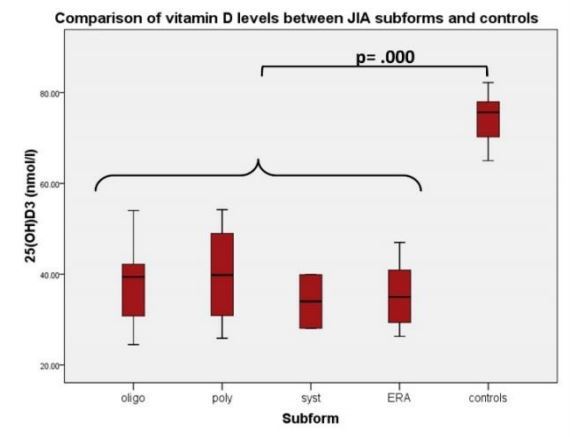Arthritic children have low vitamin D (84 percent of the studies)
Vitamin D and juvenile idiopathic arthritis.
Pediatr Rheumatol Online J. 2018 May 16;16(1):34. doi: 10.1186/s12969-018-0250-0.
Finch SL1, Rosenberg AM2, Vatanparast H3.
1 College of Pharmacy and Nutrition, University of Saskatchewan, Saskatoon, Canada.
2 Department of Pediatrics, University of Saskatchewan, Saskatoon, Canada.
3 College of Pharmacy & Nutrition and School of Public Health, University of Saskatchewan, 104 Clinic Place, Saskatoon, SK, S7N 2Z4, Canada. [email protected].
 * Juvenile Rheumatoid Arthritis 8 X more likely if poor Vitamin D receptor – Dec 2017* More UVB at 12th week of pregnancy associated with less Juvenile Idiopathic Arthritis – Oct 2018Items in both categories Rheumatoid Arthritis and infant-Child are listed here: {category}BORON not mentioned in the study on this page* Rheumatoid arthritis and many other diseases associated with low Boron – 2012* Children with Idiopathic arthritis have very low Boron levels – Jan 2016* Vitamin D and Boron **category listing has items along with related searches** * Boron and Granulomas (TB, Rheumatoid arthritis, Crohn's, Rheumatic Fever etc.) - 2015* Far fewer joint problems (Osteochondrosis) when Boron was added to diet (pigs)
* Juvenile Rheumatoid Arthritis 8 X more likely if poor Vitamin D receptor – Dec 2017* More UVB at 12th week of pregnancy associated with less Juvenile Idiopathic Arthritis – Oct 2018Items in both categories Rheumatoid Arthritis and infant-Child are listed here: {category}BORON not mentioned in the study on this page* Rheumatoid arthritis and many other diseases associated with low Boron – 2012* Children with Idiopathic arthritis have very low Boron levels – Jan 2016* Vitamin D and Boron **category listing has items along with related searches** * Boron and Granulomas (TB, Rheumatoid arthritis, Crohn's, Rheumatic Fever etc.) - 2015* Far fewer joint problems (Osteochondrosis) when Boron was added to diet (pigs)📄 Download the PDF from Vitamin D Life
BACKGROUND:
Vitamin D has been implicated in the pathogenesis of autoimmune diseases. While the roles of vitamin D in other autoimmune diseases have been investigated, less is known about the role of vitamin D in chronic childhood arthritis.
MAIN BODY:
This review summarizes and evaluates evidence relating to 25-hydroxyvitamin D (25(OH)D) and chronic childhood arthritis. A scoping literature review was conducted using Ovid Medline, Ovid Embase, Cumulative Index to Nursing and Allied Health Literature, Web of Science and Scopus. Further, we geo-mapped the results of the studies to identify the patterns of the association between vitamin D and chronic childhood arthritis across the globe. Of 38 studies reporting 25(OH)D concentrations in childhood chronic arthritis, 32 (84.2%) reported that a significant number of children had suboptimal (< 75 nmol/L) status.
CONCLUSION:
The data indicate suboptimal vitamin D status in children with chronic arthritis. Further, the association between low vitamin D and increased arthritis activity follow a north-south geographical gradient.
